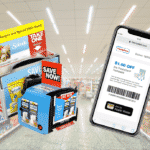
Some prefer paper coupons, others digital, but both formats have their drawbacks. You have to remember to clip and carry around paper coupons, and they’re easily abused by fraudsters and counterfeiters. Digital coupons can only be used at the specific store whose website or app offers them, and it’s hard to be sure if they’re all being applied to your order correctly.
Surely, there’s got to be a better way?
There is now. A whole new coupon format that combines the versatility of paper coupons with the convenience of digital coupons has just made its public debut. And these new coupons, which you won’t forget at home, which are resistant to counterfeiting and fraud, and can be used anywhere you choose to shop, are heading your way soon.
For several years, the coupon industry has been working behind the scenes to perfect new standards that would allow for a “universal digital coupon” – a bar-coded coupon displayed on your phone that can be used anywhere coupons are accepted. That led to last year’s creation of The Coupon Bureau, an industry-backed group that has been developing the new coupon format and tested it in a real-world environment for the first time last week. And now, they say, their creation is ready for prime time.
And what will it mean for you? “It means you don’t have to go searching all over the place for coupons and promotions. They’re going to come to you,” The Coupon Bureau CEO Brandi Johnson told Coupons in the News.
Shoppers at Elden’s Fresh Foods, an independently-owned grocery store in Alexandria, Minnesota, were the first to try out the new coupons last week. Customers were sent a coupon via email, and got a quick and easy discount just by scanning a bar code on their phone at the checkout.
If you’ve ever used a mobile coupon before, you might be thinking, what’s the big deal? Well, up until now, mobile coupons were almost exclusively store coupons. Manufacturer’s coupons have largely been limited to paper and load-to-card digital formats, because mobile manufacturer’s coupons presented a number of challenges that had to be addressed. Chief among them: how do you keep shoppers from using them more than once, taking screen shots or sharing them with others?
And, as long as the industry was creating a new coupon format from scratch, why not address some other issues with coupons in general, like how to ensure they’re used correctly, on the correct products?
The solution is in the bar code itself. The Coupon Bureau’s mobile coupons are in a unique format, where not all of the coupon’s information is in the actual bar code. Instead, when a cashier scans your coupon, the bar code triggers a call to The Coupon Bureau’s centralized database. That system will tell the store’s register whether the coupon is a known, legitimate offer, whether that particular coupon has ever been used before, and precisely what item on which it’s valid, with much more precision than a current coupon bar code is capable of.
This could help put an end to “glitching”, where coupon users use high-value coupons on lower-priced items on which they’re not intended. It could help put an end to counterfeiting, since only known coupons will reside in The Coupon Bureau’s positive offer file, and fakes will be rejected. And it could help put an end to reuse or overredemption – once that particular coupon is used, it can never be used again.
That may not please the fraudsters, but it’s good news for retailers, manufacturers and couponers. First, it reduces the potential for conflict at the checkout – cashiers won’t have to scrutinize your coupon to make sure it’s legit, because they really can trust the bar code to do the work. “We took the friction away between the cashier and the shopper. The cashier doesn’t have to be the final say in validation,” Johnson said.
Also, if manufacturers have peace of mind in knowing that their coupons won’t be abused, misused or counterfeited, “there will be more coupons, and hopefully more high-value, more meaningful coupons,” Johnson said. “We’ve seen manufacturers say, when I can be specific about the exact product or size I want the shopper to purchase, and that can be controlled, then I’ll do higher value offers.”
And then there’s the fact that, unlike store-specific digital load-to-card coupons, universal digital coupons can be used anywhere. And that will make it easier for brands to send their coupons directly to you. Have you ever seen a store circular telling you to look through your Sunday newspaper inserts for a particular coupon, or an email or ad banner inviting you to scroll through a particular store’s digital coupon gallery to find a specific coupon you can use? It’s a clunky and not very effective way to deliver a coupon to you, by making you go look for it.
But now, if you sign up to receive emails or texts from your favorite brands, or click on an ad banner online, or visit a brand’s website, you’ll be able to get a mobile coupon sent to you right away that you can use wherever you want to shop. Or you can pull out your phone to scan a code in a circular, in a store, or on a product package to access a coupon. Or you can have a mobile coupon beamed to your phone with an in-store beacon. The possibilities are almost limitless.
Eventually, the goal is to make universal digital coupons redeemable online as well as in-store. You can save them to a mobile wallet, redeem them one at a time by scanning each one at the checkout, or a “bar code bundling” feature where multiple coupons can be combined into a single bar code, is in the works.
The Coupon Bureau is working on behalf of the entire industry to establish the framework and the standards. It will be up to manufacturers and coupon providers to create and deliver the coupons themselves. The test at Elden’s last week was designed to show that the technology works.
“Not only did it work, but it was easy – it didn’t slow down registers, the shoppers liked it,” Johnson said. “They were pleasantly surprised with the ease of being able to obtain the offer and then use it at the store. And you’re not going to get somewhere and forget your coupons, because you’ve always got your phone in your hand.”
Unlike countless ideas over the years pitched by startups that promised and failed to “revolutionize the coupon industry,” this initiative actually has the backing of the coupon industry. Numerous retailers, manufacturers and coupon providers are already on board, so this is no theoretical concept that you’ll never hear about again. It’s for real – and it’s coming soon.
“We’re having conversations with all the large national retailers,” Johnson said. As more manufacturers and retailers begin issuing and accepting universal digital coupons, more shoppers in more parts of the country will gain access to them in the new year. “We believe that by midyear, we should have a Bureau-connected retailer within five miles of every shopper in the U.S.,” Johnson predicted.
So whether you prefer cutting out paper coupons, or loading digital coupons to your store loyalty account, you’ll soon have a third option. After so many would-be innovators have promised revolutionary coupons that never came to pass, universal digital coupons represent one promise that the entire coupon industry is determined to deliver on.
Image source: Trenton Johnson / The Coupon Bureau
















About time….and though this is in the U.S., and here in Canada, scanning paper coupons barcodes is not a thing as retailers here manually input coupons, sure hope this trickles up here so it cuts down on the scamming we do see here.
This technology has been invented a while back. Good to see it’s happening now and the industry is accepting it.
This is a thorough, well-written story that represents true breakthrough innovation for the coupon industry! Kudos to everyone involved in driving this important, much-needed change!